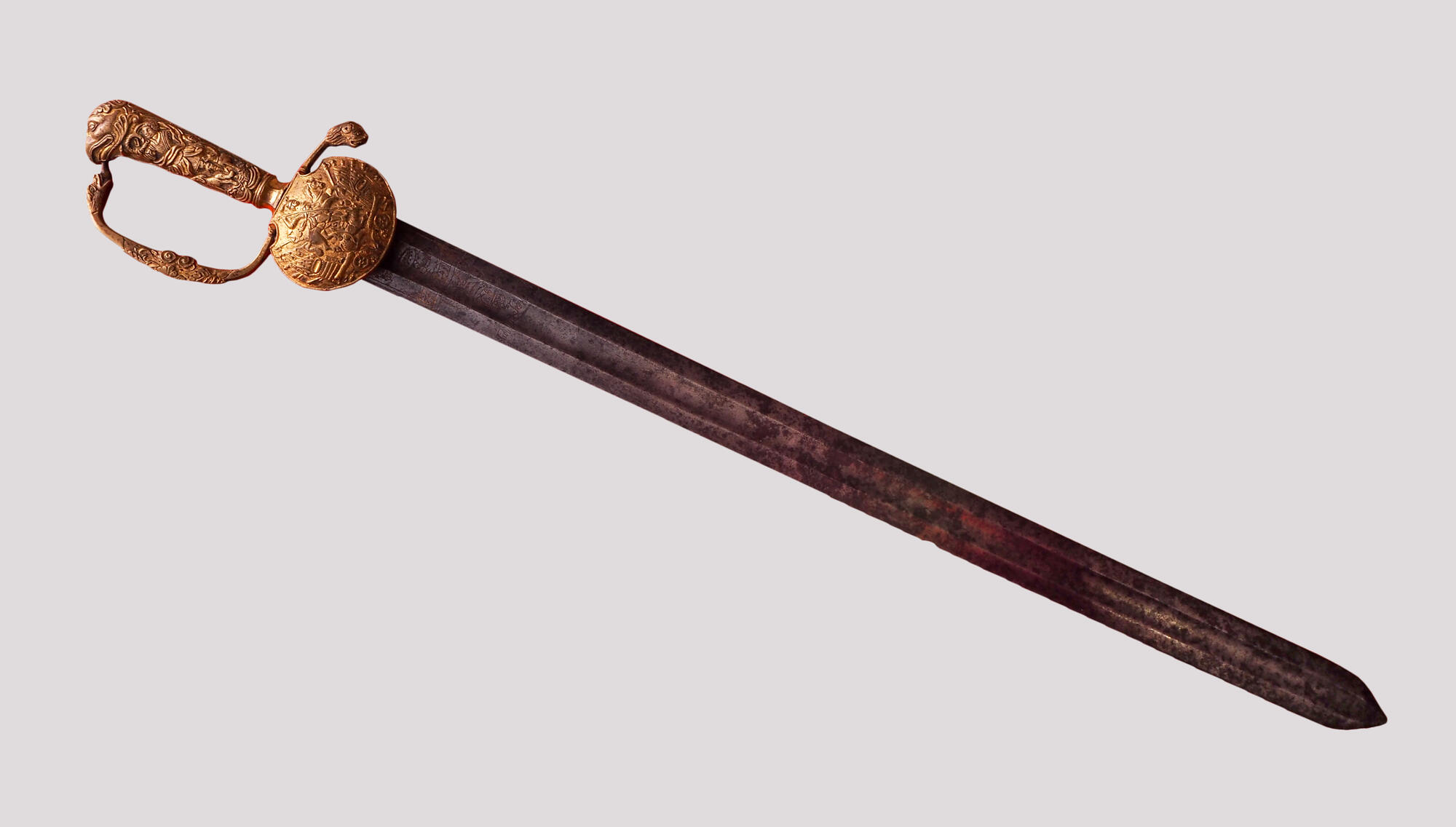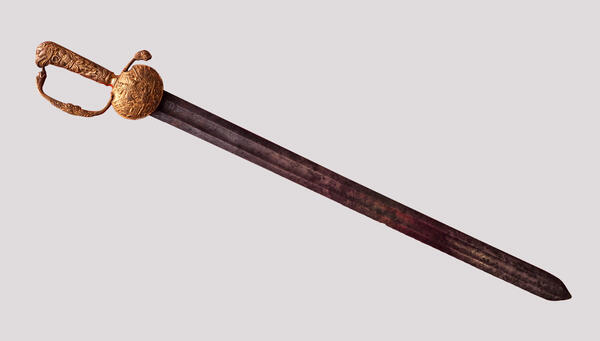Broadsword is a cut and thrust bladed weapon, usually with one-sided sharpening. The broadsword was widespread in Europe and Asia and came to Russia only at the end of the 16th century, together with foreign officers recruited into service. As a model of mass weapons, the broadsword was adopted in the Russian army during the time of Peter I and was later used in the dragoon regiments. There were award broadswords, which were presented to the servicemen for excellent service.
A broadsword from the Smolensk Museum is an example of ceremonial award weapons of the first quarter of the 18th century. Its straight wide blade with a fuller is decorated with a magnificent engraving depicting Tsar Peter I and an inscription in Latin letters: ‘Vivat, Tsar Peter Alekseevich.’ The handle of the broadsword is gilded. The broadsword has a traditional guard and a hilt decorated with the heads of an eagle and a basilisk. On the handle itself is a hunter with two dogs blowing a horn. It is a symbol of glory, loyalty and vigilance. On the guard there is a decorative shield with a complex plot: Saint George, framed by banners, slaying the dragon. Especially interesting is the fact that the traditional dragon is reclining on quite realistically depicted cannons. This is an unconditional allusion to the victories of Tsar Peter I.
The broadsword is dated 1715. At that time, Russia participated in the Northern War and continued to triumph. This broadsword was an award for a high-ranking officer, as evidenced by the richness and complexity of the decorative trim of the hilt.
The tradition of awarding weapons for military exploits in Russia appeared in the first half of the 17th century, when the boyar Khitrovo was awarded the saber under Tsar Mikhail Fedorovich. In the future, this custom was supported by other rulers, but only under Peter I, with the creation of a regular army and navy, award weapons received legal status. Therefore, we can consider that this broadsword is one of the first samples of award weapons in the country. In those years, good quality steel blades were not yet produced in Russia, and a significant part of the weapons was created based on drafts coming from the German city of Solingen. However, the nature of the images on the sword hilt suggests that the decoration of the weapon was created directly in Russia.
A broadsword from the Smolensk Museum is an example of ceremonial award weapons of the first quarter of the 18th century. Its straight wide blade with a fuller is decorated with a magnificent engraving depicting Tsar Peter I and an inscription in Latin letters: ‘Vivat, Tsar Peter Alekseevich.’ The handle of the broadsword is gilded. The broadsword has a traditional guard and a hilt decorated with the heads of an eagle and a basilisk. On the handle itself is a hunter with two dogs blowing a horn. It is a symbol of glory, loyalty and vigilance. On the guard there is a decorative shield with a complex plot: Saint George, framed by banners, slaying the dragon. Especially interesting is the fact that the traditional dragon is reclining on quite realistically depicted cannons. This is an unconditional allusion to the victories of Tsar Peter I.
The broadsword is dated 1715. At that time, Russia participated in the Northern War and continued to triumph. This broadsword was an award for a high-ranking officer, as evidenced by the richness and complexity of the decorative trim of the hilt.
The tradition of awarding weapons for military exploits in Russia appeared in the first half of the 17th century, when the boyar Khitrovo was awarded the saber under Tsar Mikhail Fedorovich. In the future, this custom was supported by other rulers, but only under Peter I, with the creation of a regular army and navy, award weapons received legal status. Therefore, we can consider that this broadsword is one of the first samples of award weapons in the country. In those years, good quality steel blades were not yet produced in Russia, and a significant part of the weapons was created based on drafts coming from the German city of Solingen. However, the nature of the images on the sword hilt suggests that the decoration of the weapon was created directly in Russia.



